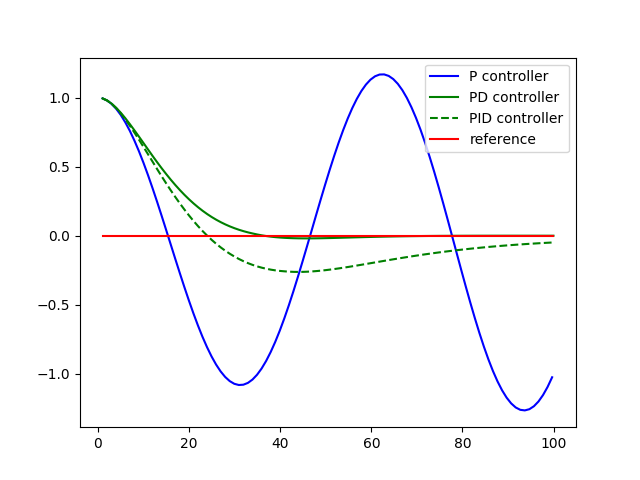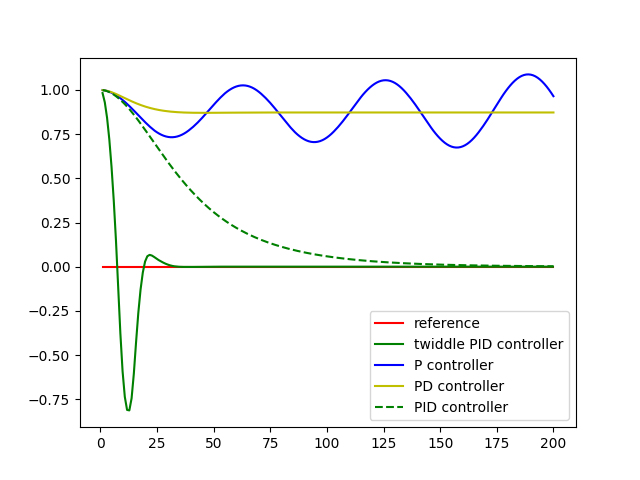Objective: Implementing a PID controller algorithm in C++ to solve a steering angle problem from a simulator of a car driving on a predefined circle track (reference trajectory).
Environment setup and boilerplate code provided by Udacity under https://github.com/udacity/CarND-PID-Control-Project.
Improvements made to:
- src/main.cpp
- src/PID.cpp
Basic algorithm
In main.cpp the PID controller is initialized with a set of 3 params (Kp, Ki, Kd) calling the Init() function of the pid instance. The parameters scale effects of the Cross Track Error (CTE) to determine the new steering value. This value equals the total error calculated in function TotalError() that the algorithm is trying to minimize. In case the steer value is violating the vehcile spec it is limited to the min/max steering ability (-1 to 1) of the vehicle. PID.cpp implements the UpdateError() function with the proportional, integral and differential errors.
Effects of the hyperparameter
Speed throttle set to 0.3. The parameters (Kd, Ki, Kd) where determined manually starting with a proportional term (1,0,0), where the car went off track immediatly. Reducing to (0.1,0,0) decreased the amplitude of the steer angle significantly and as expected, but the car remained oszillating and running off track soon. Introducing a differential term (0.1,0,1) helped to reduce the oszillation and the car completed the track successfully. Increasing the speed throttle to 0.6 resulted in stronger oszillation mitigated with a higher differential term (0.1,0,1.4). To mitigate any biases a small integral term (0.1,0.005,1.4) lead to some overshooting in curves but didnt improve the overall driving behavior, thus dropped back to 0. Expected effects can be visulized conceptually, see "PID".
The proportional (P) term has the most directly effect on the car's behavior. It steers proportional to the car's distance from the lane center (CTE) - if the car is far out to one side of the road it steers hard to the other, if it's instead slightly to one side it steers only slightly to the other, thus it reacts proportionally to the error and can be called proportional gain. With large CTE, the gain is porportional large, with small CTE the gain is proportional small. However, the term overshoots and to correct this we need an additional term.
The differential (D) term counteracts the proportional's tendency to oszillate and overshoot the center line (CTE). A tuned differential term makes the car approach the center line smoothly without oszillation around the reference trajectory. It uses the rate of change of CTE orthogonal to the reference trajectory. If the change is zero the car perfectly follows the trajectory but if the car is repeatedly overshooting the D term corrects the error difference. A well tuned derivative term prevents under- or overdamped trajectory.
The integral (I) term mitigates a bias in the CTE which appear for steady or constant shifts of the car from the center line. Bias can be caused by drift, any imperfection in the vehicle construction or any external influence on the car causing a lane offset.
Additional information can be found in this video: Controling self driving cars
PID
Finding the hyperparameter
Further "try and observe" in incremental steps led to the final paramters (0.095,0,1.35) at speed throttle 0.55. Another way of determining the parameters more "sofisticatedly" is to implement a Coordinate Ascent algorithm that converges fast but overshoots initially and needs to be tuned too, see "TWIDDLE".
TWIDDLE
Passing the project requires a successful simulator track run and documentation, pls see project rubric https://review.udacity.com/#!/rubrics/824/view.
This project involves the Term 2 Simulator which can be downloaded here: https://github.com/udacity/self-driving-car-sim/releases. A server package uWebSocketIO is setting up a connection from the C++ program to the simulator, which acts as the host.
Basic Build Instructions: run shell-commands from the project directory
- Clone this repo.
- Make a build directory:
mkdir build && cd build - Compile:
cmake .. && make - Run it:
./pid. - Run and start the simulator (resolution: 600x800, Mode: fastest)
Vehicle stays on track for multiple rounds with top speed of 60mph.
For this speed, in certain situations the car is oszillating, but staying in the limits of the road. Supposedly, for a regular passenger this would not be acceptable, but could eg. improved by
- drive slower, eg 30mph
- implementing a throttle PID controller that reduces speed for curves and accelerates again accordingly

